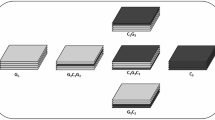Abstract
In this article, the effect of pristine and carboxyl functionalized carbon nanotube (CNT and FCNT) reinforcement on the durability of glass fiber-reinforced epoxy (GE) composite has been assessed under repeated hydrothermal cycling (HC) and compared with that of control GE composites. Each HC constitutes of 24 h conditioning in a water bath maintained at 15 °C followed by further 24 h water aging at 50 °C. Control GE, 0.1 wt % pristine CNT-embedded GE (CNT-GE) and 0.1 wt % FCNT-embedded GE (FCNT-GE) were exposed to 20, 40, and 60 number of HC in order to assess their durability. Initially, for a lower number of HC, FCNT-GE composite was found to have the best water resistance followed by CNT-GE and GE composites, whereas after 40 and 60 number of HC, the trend got modified. Flexural testing was conducted to evaluate the durability of these composites upon 20, 40, and 60 number of HC. Also, the degree of recovery in the flexural properties of the composites after 60 number of HC was evaluated by conducting desorption process. The cyclic changes in water bath temperature caused interfacial debonding at the CNT/matrix interface resulting in accelerated water absorption and reduced flexural performance. The water absorption by the composites had deleterious effect on their glass transition temperature (Tg) and matrices chemical bonding. The variation in the failure modes in these composites, before cycling and after 60 number of HC, was compared using SEM analysis.
Graphical Abstract








Similar content being viewed by others
References
Patel V A, Bhuva B D, and Parsania P H, J Reinf Plast Compos. 28 (2009) 2549.
Sapiai N, Jumahat A, Shaari N, and Tahir A, Mater Today Proc. 46 (2021) 1787.
Bal S, and Saha S, Int J Damage Mech. 26 (2017) 758.
Meenalochani K S, and Reddy B V, Int J Innov Res Adv Eng. 4 (2017) 143.
Jiang X, Song J, Qiang X, Kolstein H and Biilaard F, Moisture Absorption/Desorption Effects on Flexural Property of Glass-Fiber-Reinforced Polyester Laminates: Three-Point Bending Test and Coupled Hygro-Mechanical Finite Element Analysis. Polymers [Internet]. 2016;8. Available from: https://www.mdpi.com/2073-4360/8/8/290.
Ellyin F, and Maser R, Compos Sci Technol 64 (2004) 1863.
Fulmali A O, Sen B, Nayak B A, and Prusty R K, Polym Compos 42 (2021) 6160.
Sen B, Fulmali AO, Prusty RK and Ray BC, A Study of the Effect of Carbon Nanotube/Nanoclay Binary Nanoparticle Reinforcement on Glass Fibre/Epoxy Composites. Mater Today Proc. 2020.
Fulmali AO, Sen B, Ray BC and Prusty RK, Effects of Carbon Nanotube/polymer Interfacial Bonding on the Long-Term Creep Performance of Nanophased Glass Fiber/Epoxy Composites. Polym Compos [Internet]. 0. Available from: https://onlinelibrary.wiley.com/doi/abs/https://doi.org/10.1002/pc.25381.
De S, Shivangi P N, Choudhury S, Fulmali A O, Ray B C, and Prusty R K, J Appl Polym Sci 138 (2021) 51231.
Mahato K K, Fulmali A O, Kattaguri R, Dutta K, Prusty R K, and Ray B C, IOP Conf Ser Mater Sci Eng 338 (2018) 012057.
Nayak R K, Mahato K K, and Ray B C, Compos Part Appl Sci Manuf. 90 (2016) 736.
Prusty R K, Rathore D K, and Ray B C, Compos Part Appl Sci Manuf. 101 (2017) 215.
Vaisman L, Wagner H D, and Marom G, Adv Colloid Interface Sci. 128–130 (2006) 37.
Garg M, Sharma S, and Mehta R, J Mater Sci 51 (2016) 8562.
Krauklis A E, and Echtermeyer A T, Open Chem 16 (2018) 1189.
Gautier L, Mortaigne B, and Bellenger V, Compos Sci Technol 59 (1999) 2329.
Tsagaropoulos G, and Eisenberg A, Macromolecules 28 (1995) 6067.
Starkova O, Buschhorn S T, Mannov E, Schulte K, and Aniskevich A, Eur Polym J 49 (2013) 2138.
Jiang N, Yu T, and Li Y, J Polym Environ 26 (2018) 3176.
Blanco I, Cicala G, Costa M, and Recca A, J Appl Polym Sci 100 (2006) 4880.
Cotugno S, Mensitieri G, Musto P, and Sanguigno L, Macromolecules 38 (2005) 801.
Liu Y, Kang H, Gong X, Jiang L, Liu Y, and Wu S, RSC Adv 4 (2014) 22367.
Acknowledgements
The authors express their heartfelt gratitude toward National Institute of Technology, Rourkela, India and Science and Engineering Research Board, India (ECR/2018/001241) for providing their financial and infrastructural support to carry out this research work.
Author information
Authors and Affiliations
Corresponding author
Additional information
Publisher's Note
Springer Nature remains neutral with regard to jurisdictional claims in published maps and institutional affiliations.
Rights and permissions
Springer Nature or its licensor (e.g. a society or other partner) holds exclusive rights to this article under a publishing agreement with the author(s) or other rightsholder(s); author self-archiving of the accepted manuscript version of this article is solely governed by the terms of such publishing agreement and applicable law.
About this article
Cite this article
Fulmali, A.O., Kumar, A. & Prusty, R.K. Effect of Hydrothermal Cycling on CNT-Embedded Glass Fiber-Reinforced Polymer Composites: An Emphasis on the Role of Carboxyl Functionalization. Trans Indian Inst Met 76, 1799–1807 (2023). https://doi.org/10.1007/s12666-023-02891-8
Received:
Accepted:
Published:
Issue Date:
DOI: https://doi.org/10.1007/s12666-023-02891-8




